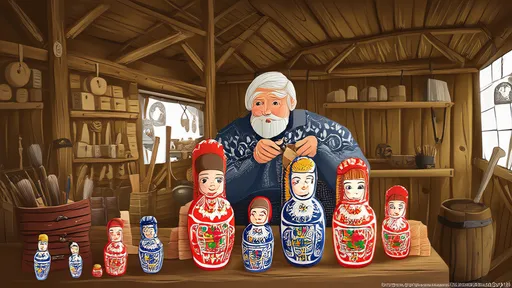Nestled in the heart of Russia’s historic craft regions, the Sergei Hand-Painted Factory stands as a testament to the enduring legacy of matryoshka dolls. These iconic nesting dolls, often referred to as Russian babushka dolls, have captivated collectors and art enthusiasts for generations. What sets Sergei’s workshop apart is not just the precision of their craft but the soulful artistry infused into every piece. Each doll tells a story, painted with meticulous care by artisans who have spent decades perfecting their techniques.
The factory, though modest in size, buzzes with an energy that feels almost timeless. Visitors are greeted by the faint scent of birch wood and acrylic paints, a sensory prelude to the vibrant creations lining the shelves. Unlike mass-produced versions found in tourist shops, Sergei’s dolls are unmistakably unique. The artisans here work exclusively with hand-turned wood, ensuring that no two dolls are identical. The imperfections—a slightly uneven curve or a brushstroke that betrays human touch—are celebrated rather than concealed.
A Tradition Passed Down Through Generations
The history of the Sergei Hand-Painted Factory is as layered as the dolls themselves. Founded in the early 20th century by Sergei Ivanov, a master woodturner disillusioned with the industrialization of crafts, the workshop was conceived as a sanctuary for traditional methods. Ivanov’s philosophy was simple: art should be slow, deliberate, and deeply personal. Today, his great-granddaughter, Anastasia, oversees operations, preserving his ethos while subtly modernizing designs to appeal to contemporary audiences.
Anastasia often speaks of the factory as a living museum. "We aren’t just making dolls," she says. "We’re keeping alive a language of symbols and motifs that would otherwise fade away." Indeed, the floral patterns, peasant costumes, and folklore scenes adorning the dolls are more than decorative—they’re visual narratives of Russian rural life. Some designs pay homage to specific regions, like the golden wheat sheaves of Kuban or the icy blues of Siberian winters. Others depict characters from Slavic fairy tales, their faces alive with mischief or wisdom.
The Painstaking Process Behind Each Doll
Creating a single matryoshka set at Sergei’s factory can take weeks, sometimes months. It begins with selecting the right wood—linden or birch, aged for years to prevent cracking. The logs are hand-cut into rough blocks, then shaped on a lathe by craftsmen who rely on touch as much as sight. "You have to feel the wood," explains Dmitri, a third-generation turner. "It tells you where it wants to bend, where it wants to stay firm."
Once the nesting shells are perfected, they’re handed to the painters, who work with squirrel-hair brushes so fine they can render eyelashes in a single stroke. The pigments, mixed in-house from natural minerals and dyes, produce hues that glow with depth. Unlike printed decals used in factories, every line here is applied freehand. A single mistake means starting over—a rule enforced ruthlessly. "We don’t cover errors with extra paint," says Irina, the lead artist. "If it’s not flawless, it’s not ours."
The final step is the application of food-grade lacquer, polished to a satin finish that enhances the colors without glare. This stage is crucial; too much lacquer dulls the details, too little leaves the paint vulnerable. The artisans judge the sheen by holding each doll under north-facing light, a trick passed down from Sergei himself.
More Than Souvenirs: The Cultural Significance
To dismiss matryoshka dolls as mere trinkets is to misunderstand their cultural weight. In Sergei’s workshop, they’re treated with near-reverence. "These aren’t toys," Anastasia insists. "They’re vessels of memory." During Soviet times, when religious iconography was suppressed, matryoshkas often hid painted saints inside their innermost shells—a silent act of defiance. Today, they serve as diplomatic gifts, with custom sets depicting world leaders or cultural symbols to foster international goodwill.
Collectors prize Sergei’s limited-edition sets, particularly the "Four Seasons" series, where each layer represents a different month in the Russian agrarian calendar. The winter doll, for instance, wears a sheepskin coat with snowflake embroidery so intricate it requires a magnifying glass to fully appreciate. Another coveted line features Pushkin’s literary heroines, their faces modeled after 19th-century miniature portraits.
Challenges and the Future
Despite their acclaim, the factory faces an uncertain future. The average age of the artisans is 57, and few young apprentices are willing to endure the years of grueling training. "You can’t rush mastery," Dmitri sighs. "Kids today want quick results." Rising material costs and competition from cheap imports add to the strain. Yet there’s hope: recent collaborations with fashion designers (who use the dolls’ patterns in textiles) and a surge in eco-conscious consumers seeking sustainable art have brought new attention.
Anastasia remains optimistic. She points to the factory’s online workshops, where enthusiasts worldwide learn basic techniques. "Maybe they’ll never carve like us," she says, "but they’ll understand why it matters." As sunlight filters through the workshop windows, illuminating a half-painted doll whose eyes seem to twinkle with secrets, it’s hard not to believe her. The matryoshkas will endure—one careful brushstroke at a time.
For those lucky enough to hold a Sergei original, the experience is transformative. The weight of the wood, the whisper of nested pieces fitting together, the dizzying detail that rewards every closer look—it’s a tactile connection to a craft that refuses to be commodified. In a world of disposable goods, these dolls are made to last, to be passed down, and to keep unfolding their stories for generations unseen.

By /Aug 4, 2025

By /Aug 4, 2025

By /Aug 4, 2025

By /Aug 4, 2025

By /Aug 4, 2025

By /Aug 4, 2025

By /Aug 4, 2025

By /Aug 4, 2025

By /Aug 4, 2025

By /Aug 4, 2025

By /Aug 4, 2025

By /Aug 4, 2025

By /Aug 4, 2025

By /Aug 4, 2025

By /Aug 4, 2025

By /Aug 4, 2025

By /Aug 4, 2025

By /Aug 4, 2025

By /Aug 4, 2025

By /Aug 4, 2025